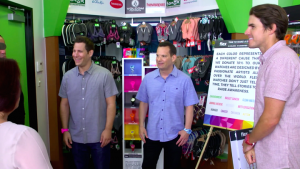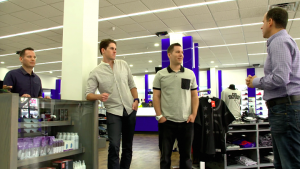
Reviewing their inspiration board. Via CNBC.
We loved working with the Flex Watch founders and their investor, Marcus Lemonis, on a recent episode of this season’s CNBC’s series “The Profit.” When we met with team Flex, our role was simple — re-aligning the brand, which was faced with a tangle of confusing advertising and slumping sales. Like many businesses, Flex launched strong, but lost its way in the clutter of market competition. When they launched in 2010, the company, whose tagline is “Time to Make a Difference,” had a clear vision and purpose-driven direction. They offered 10 colors of watches, donating 10% of the profits to 10 set charities. A straightforward and well-defined approach that saw strong company growth for the first two years. But as Flex caved to market pressure and begun expanding their offerings to include more expensive items and redirecting their market to a newer “hip” consumer base, sales began to falter.

Flex Watches pitching Flip Flop Shop. Via CNBC.
As the episode showed, the team struggled to find solutions; however, with renewed focus and outside help, the team was able to connect back with its authentic, essential brand, telling its story with purpose.
The Flex team problems aren’t unique. Losing sight of brand story and an overarching vision and mission aren’t just the problems of early days of frenetic start-ups, they can happen at any stage of growth. Take for instance, behemoth brand McDonald’s. With weak sales and sluggish growth, the fast food giant needed a way to re-shape public perceptions. With the launch of the global digital campaign, “Our Food Your Questions,” the company hopes to remind customers of its original brand promise of quality fast food. Will today’s nutrition-smart eater trust the brand to deliver its promise? It’s probably too soon to tell. But we can generalize that messaging reminders and repeats of brand values or promises do not pivot a brand for growth or spark nutrition, dietary or food conversations the public cares about.

Marcus Lemonis and the Flex Watches team. Via CNBC.
Some companies align brand, story and message tightly, gaining competitive advantage without sacrificing history, essence and identity. Southwest Airlines, for example, has built its brand around trust from its niche origins as a low-cost air carrier. By positioning itself outside the mainstream largess of other commercial airlines, the company has developed loyalty and trust while also using brand story to broaden conversations beyond ticket prices. With its “Transfarency” campaign, Southwest adds layers into its brand history while leading a conversation people want and care about.
These case studies illuminate the importance of aligning brand fundamentals. Cast your brand story too far away from your vision, mission, values, and personality, and you’ll soon lose your place with audiences. Maybe McDonald’s can afford a “do-over” in the public’s mind, but not all companies have unlimited talent, money, and resources to create a cultural reinvention. Besides, consumers today tend to see right through such messaging-cum-brand story. Athletic clothing line Lululemon has yet to regain the trust of its once passionate brand loyalists. Once its CEO lashed out at his target consumers about the “right” kind of bodies fitting into its yoga pants — poof! He went all the way “downward dog” and lost brand trust (and his job), while the company’s stock and its brand story took a hefty hit and has never fully recovered.
That’s because we’re living in an age of brand transparency. Consumers expect a real partnership with companies, more than marketing. It means doing research and matching core brand offerings to what consumers want, need and value. They’ll buy from you so long as you make their lives better, even a teensy weensy bit. It means giving consumers key information about the brand, company, and products, which is often achieved through the brand personality. It’s giving a peek into not just how the business “works,” but long exchanges with the values and passions of the founders and the company. And if this isn’t authentic or genuine or transparent, like the Flex Watches before their brand pivot episode, you’ll find yourself adrift amidst the competition.

Comments ( 0 )